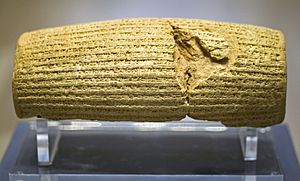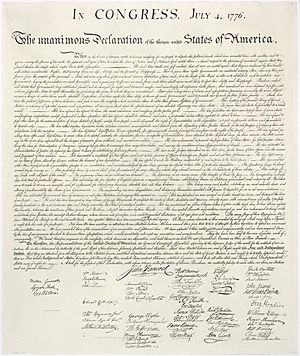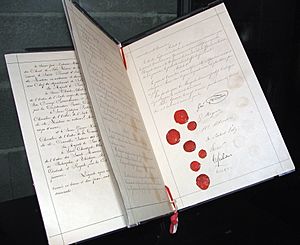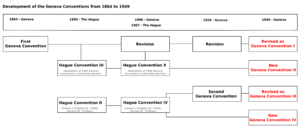History of human rights facts for kids
The idea of human rights, which are basic freedoms and protections for everyone, has a long and interesting history. While many ancient religions believed in the importance of human life, the modern ideas of human rights really started during the Renaissance and Early Modern period.
After many wars in Europe, especially in the 1600s, people started thinking about natural rights. These are rights that people have just because they are human, not because a government gives them. These ideas became very important during the Age of Enlightenment in the 1700s.
The American Revolution and French Revolution at the end of the 1700s were based on these ideas of natural rights. Over time, more and more people gained the right to vote, leading to universal suffrage in the 1900s. After two big World Wars, countries came together to create the Universal Declaration of Human Rights, a very important document that lists many of these rights.
After these wars, different groups started fighting for their rights, like the women's rights movement and the Civil Rights Movement for African Americans. In the 1970s, people in countries like the Soviet bloc also pushed for more freedoms. Soon, human rights became a major topic around the world. Today, the human rights movement works on many issues, including helping people in need and supporting social and economic growth in developing countries.
The journey of human rights has been complicated. Sometimes, rights that were established were later changed or taken away, especially during wars or big cultural shifts.
Contents
Ancient and Early Times
Some old laws and religious ideas from ancient times are now seen as early forms of "human rights." While later thinkers talked about a social contract between rulers and people, ancient cultures often had similar ideas based on divine law or natural law. The modern idea of human rights is also linked to the idea of citizenship, which became clearer in the last few hundred years. Still, we can find examples of human rights ideas even in ancient times, even if people back then didn't think of them in the same way we do today.
Ancient West Asia
One of the earliest known sets of laws is from Urukagina of Lagash (around 2350 BC). The oldest complete law code we have today is the Code of Ur-Nammu (around 2050 BC). Many other law codes were made in Mesopotamia, like the Code of Hammurabi (around 1780 BC). This famous code listed rules and punishments for breaking them, covering topics like women's rights, men's rights, children's rights, and even rules for slaves.
Africa
In Ancient Egypt, people also had some basic human rights. For example, Pharaoh Bocchoris (725–720 BC) supported individual rights. He stopped people from being jailed for debt and changed laws about owning property.
Ancient Civilizations
Many historians believe that the Persian Empire under Cyrus the Great in the 6th century BC set new standards for human rights. After he conquered the Neo-Babylonian Empire in 539 BC, Cyrus issued the Cyrus cylinder. Some people today see this cylinder as the first human rights document. It allowed people to practice their own religion without being punished and stopped forced conversions. This idea of religious freedom was a big inspiration for later thinkers, especially in the United States.
However, some historians disagree, saying that calling the Cylinder a "human rights charter" is not quite right and might be political. The cylinder is now in the British Museum, and a copy is at the United Nations Headquarters.
In ancient Greece, the idea of citizenship began. All free citizens had the right to speak and vote in their political meetings.
The Twelve Tables Law in ancient Rome stated, "Privileges shall not be imposed," meaning no one should be given special treatment unfairly.
The Mauryan Emperor Ashoka (268 to 232 BCE) ruled a huge empire in South Asia. After a terrible war, Ashoka became a Buddhist and decided to focus on helping people. His Edicts of Ashoka were carved on pillars and rocks across his empire. These laws stopped religious discrimination and cruelty towards humans and animals. They also stressed the importance of tolerance. Ashoka even spoke out against killing or capturing prisoners of war.
In ancient Rome, a ius gentium was a right that a citizen had simply because they were a citizen. This idea was an early step towards the concept of rights in Western Europe. The word "justice" comes from ius. Roman laws also introduced the idea that a person is innocent until proven guilty, thanks to Emperor Antoninus Pius. Emperor Constantine the Great's Edict of Milan also gave complete freedom of religion.
The phrase "Human rights" was first used by Tertullian in a letter about religious freedom in the Roman Empire. He called fundamental human rights a "privilege of nature."
Early Islamic Caliphate
Historians generally agree that Muhammad spoke out against social problems of his time. Islamic reforms in areas like social security, family life, slavery, and the rights of women and minorities aimed to improve society. For example, Islam rejected special treatment for the rich and powerful and believed that leadership should be open to anyone with talent. Muhammad is seen as a reformer who spoke against exploiting the poor, unfair lending, murder, false agreements, and theft.
The Constitution of Medina, written by Muhammad in 622, was an agreement between Muslims, Jews, and pagans in Medina. It aimed to end fighting between tribes and set out rights and duties for everyone in the community.
Islam also brought important changes to slavery. It stated that people were presumed free and that free people could only be enslaved in very specific situations. The lives of slaves in Arabia improved greatly, as they were seen as human beings with some religious and social standing, and even some legal rights.
Reforms in women's rights affected marriage, divorce, and inheritance. Women gained legal status that was not common in other cultures, including the West, for many centuries. The dowry, which used to be paid to the father, became a gift for the wife to keep as her own property. Marriage became a "contract" where the woman's agreement was essential. Women also gained inheritance rights in a society where only male relatives usually inherited. Compared to how women were treated before Islam, these changes were a huge step forward. Muhammad gave women basic protections like property ownership, inheritance, education, and divorce rights.
Early Islamic law also had rules for military conduct and how to treat prisoners of war. These rules are seen as early examples of international humanitarian law. They included providing shelter, food, and clothing to prisoners, respecting their cultures, and preventing executions or revenge. Many of these ideas were not written into Western international law until much later.
Middle Ages
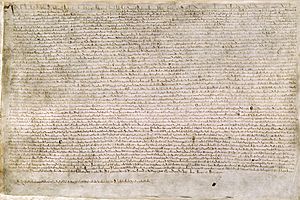
The idea of human rights in the Middle Ages was built on the idea of natural law. Early Christian thinkers like St Augustine explored whether human laws were fair and if people had to obey unfair laws.
This medieval thinking influenced the Magna Carta, an English document from 1215. It shaped common law and later documents about human rights, like the 1689 English Bill of Rights and the United States Constitution.
The Magna Carta was created because of disagreements between Pope Innocent III, King John, and English nobles about the King's power. It made the King give up some rights, follow certain legal rules, and accept that he was also bound by law. It protected certain rights of the King's subjects, especially the right of habeas corpus, which allowed people to challenge unlawful imprisonment.
For modern times, the most important part of the Magna Carta is the right of habeas corpus. It also included the right to due process, meaning fair legal treatment:
No Freeman shall be taken or imprisoned, or be disseised of his Freehold, or Liberties, or free Customs, or be outlawed, or exiled, or any other wise destroyed; nor will We not pass upon him, nor condemn him, but by lawful judgment of his Peers, or by the Law of the Land. We will sell to no man, we will not deny or defer to any man either Justice or Right.
The statute of Kalisz (1264) gave special rights to the Jewish minority in the Kingdom of Poland, protecting them from unfair treatment and hate speech.
At the Council of Constance (1414–1418), a scholar named Pawel Wlodkowic spoke about Christians and pagans living together peacefully. He was an early supporter of religious tolerance in Europe.
Early Modern Period and Modern Foundations
Age of Discovery and Enlightenment
When Spain conquered the Americas in the 1400s and 1500s, there was a big debate about human rights in the Spanish colonies. This led to the Laws of Burgos in 1512. A friar named Antonio de Montesinos spoke out against the treatment of native people, which encouraged the Spanish Crown to act. These laws included rules about child labor, women's rights, wages, housing, and rest time.
In the 1600s and 1700s, European thinkers like John Locke developed the idea of natural rights. Locke believed people are naturally free and equal because they are creations of God. His ideas were very important for the modern understanding of rights. Lockean natural rights didn't depend on being a citizen or any state law; they applied to everyone. Around the same time, in 1689, the English Bill of Rights was created, which protected basic human rights, like freedom from cruel and unusual punishment.
In the 1700s, novels became popular. Books like Julie, or the New Heloise and Pamela; or, Virtue Rewarded helped people understand and care about characters different from themselves, laying a foundation for accepting human rights.
Two major revolutions happened in the 1700s: in the United States (1776) and in France (1789). The Virginia Declaration of Rights (1776) listed many basic rights and freedoms. The United States Declaration of Independence famously stated that "all men are created equal, that they are endowed by their Creator with certain unalienable rights, that among these are life, liberty and the pursuit of happiness." This was followed by the United States Bill of Rights in 1789, which listed specific rights like freedom of speech and the right against self-incrimination. Similarly, the French Declaration of the Rights of Man and of the Citizen defined rights for all people, not just French citizens.
19th Century to World War I
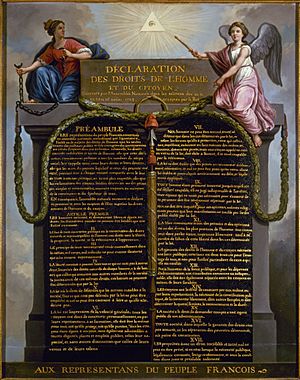
Thinkers like Thomas Paine and John Stuart Mill expanded on the idea that human rights apply to everyone in the 18th and 19th centuries.
In 1831, William Lloyd Garrison wrote in his newspaper The Liberator about "the great cause of human rights," suggesting the term was becoming common. In 1849, Henry David Thoreau wrote about human rights in his essay On the Duty of Civil Disobedience, which later influenced many human rights activists.
Many groups and movements achieved big social changes in the 20th century because of human rights. In Western Europe and North America, labor unions fought for workers' rights, safer conditions, and rules against child labor. The women's suffrage movement helped many women gain the right to vote. National liberation movements, like Mahatma Gandhi's leadership in India, helped many countries gain independence from colonial rule. Movements for equality by ethnic and religious minorities, such as the American civil rights movement, also made huge progress.
The creation of the International Committee of the Red Cross and the first Geneva Conventions in 1864 laid the groundwork for international humanitarian law, which deals with how people should be treated during war.
Ideas for United Nations human rights laws also came from the late 1800s, from movements to end slavery worldwide and to protect minorities from discrimination.
Pope Leo XIII's document Rerum Novarum in 1891 marked the start of Catholic Social Teaching. It focused on workers' rights, property rights, and citizens' rights against government interference.
In May 1915, the British, French, and Russian governments suggested that people who commit terrible acts against their own citizens could be held responsible, especially after Turkey's genocide of Armenians.
Between World War I and World War II
The League of Nations was formed in 1919 after World War I. Its goals included preventing war, settling disputes, and improving global well-being. Its founding document included a promise to promote many rights that later appeared in the Universal Declaration of Human Rights.
The League of Nations also helped former colonies of European powers become independent.
The International Labour Organization (ILO), now part of the United Nations, was also created to promote and protect certain rights:
the primary goal of the ILO today is to promote opportunities for women and men to obtain decent and productive work, in conditions of freedom, equity, security and human dignity.
Important ILO agreements include protecting women from pregnancy discrimination (1919), the right to form associations in agriculture (1921), and the Forced Labour Convention (1930).
Modern Human Rights Movement
After World War II
Rights in War and the Geneva Conventions
The Geneva Conventions were created between 1864 and 1949 thanks to Henry Dunant, who founded the International Committee of the Red Cross. These agreements protect the human rights of people involved in conflicts. They build on the Hague Conventions (1899 and 1907), which were the first attempts to define laws of war. The Geneva Conventions were updated after World War II and adopted by countries worldwide in 1949.
The main Geneva Conventions are:
- The First Geneva Convention (1949): Protects wounded and sick soldiers on land.
- The Second Geneva Convention (1949): Protects wounded, sick, and shipwrecked soldiers at sea.
- The Third Geneva Convention (1949): Deals with the treatment of prisoners of war.
- The Fourth Geneva Convention (1949): Protects civilians during wartime.
There are also three additional agreements (protocols) to the Geneva Conventions:
- Protocol I (1977): Protects victims in international armed conflicts.
- Protocol II (1977): Protects victims in non-international (civil) armed conflicts.
- Protocol III (2005): Added a new protective symbol (the Red Crystal).
Almost all 200 countries in the world have agreed to these conventions. The International Committee of the Red Cross oversees them.
Universal Declaration of Human Rights
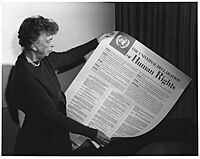
The Universal Declaration of Human Rights (UDHR) is a very important document adopted by the United Nations in 1948, partly because of the terrible events of World War II. It encourages countries to promote many human, civil, economic, and social rights. It states that these rights are the "foundation of freedom, justice and peace in the world." It was the first time in history that fundamental human rights were listed to be protected everywhere.
...recognition of the inherent dignity and of the equal and inalienable rights of all members of the human family is the foundation of freedom, justice and peace in the world
The UDHR was created by a group called the Human Rights Commission, led by Eleanor Roosevelt. They wanted to create an "International Bill of Rights." John Humphrey (a Canadian law professor) and Rene Cassin (a French lawyer) did much of the research and structured the document. The UDHR starts with basic principles like dignity, liberty, equality, and brotherhood. Then it lists rights for individuals, rights in relation to groups, political rights, and economic, social, and cultural rights. The last articles talk about limits, duties, and how these rights should be achieved in society.
The people who wrote the UDHR wanted these rights to be legally enforced. The preamble states:
Whereas it is essential, if man is not to be compelled to have recourse, as a last resort, to rebellion against tyranny and oppression, that human rights should be protected by the rule of law.
Experts from different continents and religions helped write the Declaration. It includes both civil and political rights, as well as economic, social, and cultural rights, because it was believed that all human rights are connected and equally important.
European Convention on Human Rights
After the UN Declaration, the European Convention on Human Rights (ECHR) was created in 1950. This is a binding agreement signed by 47 countries. It has 18 articles, with 13 guaranteeing specific rights:
- Right to life: Everyone has the right to live and not be unlawfully killed.
- Prohibition of torture: No one can be tortured or treated in a cruel or humiliating way.
- Prohibition of slavery: Slavery and forced labor are forbidden.
- Right to liberty and security: Everyone has the right to be free, unless they are legally imprisoned. If arrested, people have the right to know why, to go before a judge quickly, and to a trial within a reasonable time.
- Right to a fair trial: Anyone accused of a crime has the right to a public hearing by an independent judge, is presumed innocent until proven guilty, and has other basic rights like legal help and an interpreter if needed.
- Freedom from retroactive punishment: No one can be punished for something that wasn't illegal when they did it.
- Right to privacy: Everyone has the right to respect for their private and family life, home, and mail, as long as it doesn't break the law. This stops illegal police searches.
- Freedom of thought, conscience, and religion: Everyone can freely express their beliefs, change their religion, and practice their faith.
- Freedom of assembly: Everyone can form or join groups for any legal purpose.
- Right to marriage: All men and women of marriageable age have the right to marry and start a family.
- Freedom of expression: Everyone can freely express their opinions and share information, except in very specific situations.
- Freedom from discrimination: Rights in the convention cannot be denied based on sex, race, religion, political opinion, or other status.
- Right to remedy: Anyone who believes their rights have been violated can ask the European Court of Human Rights to hear their case.
The other articles deal with how these rights are enforced and when they can be limited. The United Kingdom, for example, passed the Human Rights Act 1998 to make these rights part of its own law.
Late 20th Century
According to historian Samuel Moyn, another big step for human rights happened in the 1970s. Human rights were included in the Helsinki Accords, signed in 1975 by 35 countries, including the United States and Canada.
In 1977, US President Jimmy Carter made human rights a key part of American foreign policy. The human rights group Amnesty International also won the Nobel Peace Prize in 1977. Carter himself won the Nobel Peace Prize in 2002 for his efforts to find peaceful solutions to conflicts, promote democracy and human rights, and support economic and social development.
21st Century
Human rights advocacy continues today, focusing on more economic and political freedom. In July 2022, the United Nations recognized that everyone has a right to a healthy environment. It called on countries to work harder to ensure their people have access to a "clean, healthy and sustainable environment."
See also
- Asian values
- Cairo Declaration on Human Rights in Islam
- World Conference on Human Rights



